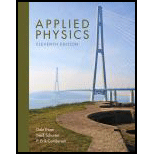
Applied Physics (11th Edition)
11th Edition
ISBN: 9780134159386
Author: Dale Ewen, Neill Schurter, Erik Gundersen
Publisher: PEARSON
expand_more
expand_more
format_list_bulleted
Concept explainers
Textbook Question
Chapter 23.7, Problem 9P
Find the percent of a
Expert Solution & Answer
Want to see the full answer?
Check out a sample textbook solution
Chapter 23 Solutions
Applied Physics (11th Edition)
Ch. 23.3 - Prob. 1PCh. 23.3 - Prob. 2PCh. 23.3 - Prob. 3PCh. 23.3 - Prob. 4PCh. 23.3 - Prob. 5PCh. 23.4 - Prob. 1PCh. 23.4 - Prob. 2PCh. 23.4 - Prob. 3PCh. 23.4 - Prob. 4PCh. 23.5 - Prob. 1P
Ch. 23.5 - Prob. 2PCh. 23.5 - Prob. 3PCh. 23.5 - Prob. 4PCh. 23.5 - Prob. 5PCh. 23.5 - Prob. 6PCh. 23.5 - Prob. 7PCh. 23.5 - Prob. 8PCh. 23.5 - Prob. 9PCh. 23.5 - Prob. 10PCh. 23.5 - Prob. 11PCh. 23.5 - Prob. 12PCh. 23.5 - Prob. 13PCh. 23.5 - Prob. 14PCh. 23.6 - Prob. 1PCh. 23.6 - Prob. 2PCh. 23.6 - Prob. 3PCh. 23.6 - Prob. 4PCh. 23.6 - Prob. 5PCh. 23.6 - Estimate the average binding energy per nucleon...Ch. 23.6 - Estimate the average binding energy per nucleon...Ch. 23.6 - Estimate the average binding energy per nucleon...Ch. 23.7 - Prob. 1PCh. 23.7 - Find the half-life of a radioactive sample if its...Ch. 23.7 - Prob. 3PCh. 23.7 - Prob. 4PCh. 23.7 - Find the percent of a sample of C55124s that will...Ch. 23.7 - Prob. 6PCh. 23.7 - Find the remaining quantity of uranium 238 atoms...Ch. 23.7 - Prob. 8PCh. 23.7 - Find the percent of a C614 sample that will decay...Ch. 23.7 - Find the percent of a radioactive sample of...Ch. 23.9 - Prob. 1PCh. 23.9 - Prob. 2PCh. 23.9 - Prob. 3PCh. 23.9 - Prob. 4PCh. 23.9 - Prob. 5PCh. 23.9 - Prob. 6PCh. 23.9 - Prob. 7PCh. 23 - Prob. 1RQCh. 23 - Einstein's equivalence principle relates to a....Ch. 23 - Prob. 3RQCh. 23 - Prob. 4RQCh. 23 - Prob. 5RQCh. 23 - Prob. 6RQCh. 23 - Describe the differences between the electric...Ch. 23 - Prob. 8RQCh. 23 - Prob. 9RQCh. 23 - What is the difference among the following...Ch. 23 - Prob. 11RQCh. 23 - Prob. 12RQCh. 23 - Prob. 13RQCh. 23 - Prob. 14RQCh. 23 - Prob. 15RQCh. 23 - What important discovery was made by Enrico Fermi?Ch. 23 - Prob. 17RQCh. 23 - Prob. 18RQCh. 23 - Prob. 19RQCh. 23 - What fraction of a radioactive sample has not...Ch. 23 - Prob. 21RQCh. 23 - Prob. 22RQCh. 23 - Prob. 1RPCh. 23 - Prob. 2RPCh. 23 - Prob. 3RPCh. 23 - Prob. 4RPCh. 23 - Prob. 5RPCh. 23 - Prob. 6RPCh. 23 - Prob. 7RPCh. 23 - Prob. 8RPCh. 23 - Prob. 9RPCh. 23 - Prob. 10RPCh. 23 - Estimate the average binding energy for R75187e...Ch. 23 - Prob. 12RPCh. 23 - Find the remaining quantity of iodine 131 atoms...Ch. 23 - Find the percent of a strontium 88 sample that...Ch. 23 - Find the percent of an osmium 191 sample that will...Ch. 23 - Prob. 16RPCh. 23 - Prob. 17RPCh. 23 - Prob. 18RPCh. 23 - Prob. 19RPCh. 23 - Prob. 20RPCh. 23 - Prob. 1ACCh. 23 - Prob. 2ACCh. 23 - The binding energy for a H24e nucleus is 28.40...Ch. 23 - Prob. 4ACCh. 23 - Prob. 5AC
Additional Science Textbook Solutions
Find more solutions based on key concepts
5. Draw a circuit that has a battery, a lightbulb, and connecting wires Draw a schematic of a water flow system...
College Physics
An advanced civilization has developed a spaceship that goes, with respect to the galaxy, only 50 km/s slower t...
Essential University Physics: Volume 2 (3rd Edition)
2. How does the frequency of an electromagnetic wave compare with the frequency of the vibrating electrons that...
Conceptual Physical Science (6th Edition)
A solid conducting wire of radius R runs parallel to the z-axis and carries a current density given by J = J0(1...
Essential University Physics (3rd Edition)
13. A 50 kg box hangs from rope. What is the tension in the rope if:
a. The box is at rest?
b. The box moves ...
Physics for Scientists and Engineers: A Strategic Approach, Vol. 1 (Chs 1-21) (4th Edition)
Q24.4 To store the maximum amount of energy in a parallel-plate capacitor with a given battery (voltage source)...
University Physics (14th Edition)
Knowledge Booster
Learn more about
Need a deep-dive on the concept behind this application? Look no further. Learn more about this topic, physics and related others by exploring similar questions and additional content below.Similar questions
- A radioactive sample initially contains 2.40102 mol of a radioactive material whose half-life is 6.00 h. How many moles of the radioactive material remain after 6.00 h? After 12.0 h? After 36.0 h?arrow_forwardSuppose you have a pure radioactive material with a half-life of T1/2. You begin with N0 undecayed nuclei of the material at t = 0. At t=12T1/2, how many of the nuclei have decayed? (a) 14N0 (b) 12N0(C) 34N0 (d) 0.707N0 (e) 0.293N0arrow_forwardThe half-life of strondum-91, 3891Sris 9.70 h. Find (a) its decay constant and (b) for an initial 1.00-g sample, the activity after 15 horns.arrow_forward
- The atomic weight of cadmium is 112.41, and its density is 8.65 g/cm3. Using Figure 14.3, estimate the attenuation distance of a thermal neutron beam in cadmium. (The attenuation distance is the distance traveled after which the intensity of the beam is reduced to 1/e of its initial value, where e is the base of the natural logarithms.)arrow_forwardundergoes alpha decay, (a) Write the reaction equation, (b) Find the energy released in the decay.arrow_forward
arrow_back_ios
arrow_forward_ios
Recommended textbooks for you
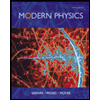 Modern PhysicsPhysicsISBN:9781111794378Author:Raymond A. Serway, Clement J. Moses, Curt A. MoyerPublisher:Cengage Learning
Modern PhysicsPhysicsISBN:9781111794378Author:Raymond A. Serway, Clement J. Moses, Curt A. MoyerPublisher:Cengage Learning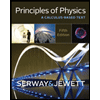 Principles of Physics: A Calculus-Based TextPhysicsISBN:9781133104261Author:Raymond A. Serway, John W. JewettPublisher:Cengage Learning
Principles of Physics: A Calculus-Based TextPhysicsISBN:9781133104261Author:Raymond A. Serway, John W. JewettPublisher:Cengage Learning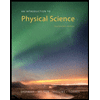 An Introduction to Physical SciencePhysicsISBN:9781305079137Author:James Shipman, Jerry D. Wilson, Charles A. Higgins, Omar TorresPublisher:Cengage Learning
An Introduction to Physical SciencePhysicsISBN:9781305079137Author:James Shipman, Jerry D. Wilson, Charles A. Higgins, Omar TorresPublisher:Cengage Learning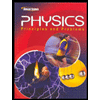 Glencoe Physics: Principles and Problems, Student...PhysicsISBN:9780078807213Author:Paul W. ZitzewitzPublisher:Glencoe/McGraw-Hill
Glencoe Physics: Principles and Problems, Student...PhysicsISBN:9780078807213Author:Paul W. ZitzewitzPublisher:Glencoe/McGraw-Hill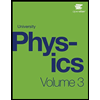 University Physics Volume 3PhysicsISBN:9781938168185Author:William Moebs, Jeff SannyPublisher:OpenStax
University Physics Volume 3PhysicsISBN:9781938168185Author:William Moebs, Jeff SannyPublisher:OpenStax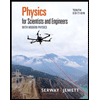 Physics for Scientists and Engineers with Modern ...PhysicsISBN:9781337553292Author:Raymond A. Serway, John W. JewettPublisher:Cengage Learning
Physics for Scientists and Engineers with Modern ...PhysicsISBN:9781337553292Author:Raymond A. Serway, John W. JewettPublisher:Cengage Learning

Modern Physics
Physics
ISBN:9781111794378
Author:Raymond A. Serway, Clement J. Moses, Curt A. Moyer
Publisher:Cengage Learning

Principles of Physics: A Calculus-Based Text
Physics
ISBN:9781133104261
Author:Raymond A. Serway, John W. Jewett
Publisher:Cengage Learning

An Introduction to Physical Science
Physics
ISBN:9781305079137
Author:James Shipman, Jerry D. Wilson, Charles A. Higgins, Omar Torres
Publisher:Cengage Learning

Glencoe Physics: Principles and Problems, Student...
Physics
ISBN:9780078807213
Author:Paul W. Zitzewitz
Publisher:Glencoe/McGraw-Hill

University Physics Volume 3
Physics
ISBN:9781938168185
Author:William Moebs, Jeff Sanny
Publisher:OpenStax

Physics for Scientists and Engineers with Modern ...
Physics
ISBN:9781337553292
Author:Raymond A. Serway, John W. Jewett
Publisher:Cengage Learning
Half life | Radioactivity | Physics | FuseSchool; Author: FuseSchool - Global Education;https://www.youtube.com/watch?v=IDkNlU7zKYU;License: Standard YouTube License, CC-BY